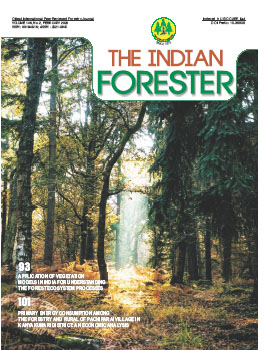Floral Diversity and Patterns of Vegetation In and Around Siswan Community Reserve (SCR) in Punjab, India
DOI:
https://doi.org/10.36808/if/2020/v146i2/142057Keywords:
Catchment Area, Shivalik, Succession, Wildlife Protection Act.Abstract
As per Wildlife Protection (Amendment) Act, 2002, a new category of Protected Areas (PAs) have been introduced as Community Reserve (CR) in India. These areas, albeit uninhabited and completely owned by the Government of india are designated as CR for subsistence of local communities. The current study collates information on the vegetation structure and composition across different forests surrounding Siswan reservoir, a newly declared Community Reserve in Punjab, India. A total of 160 species of vascular plants were recorded, of which 45.6% were herbs, 21.3% trees, 12.5% shrubs, 10% grasses, 8.8% climbers and 1.9% sedges. Fabaceae was the most dominant family followed by Poaceae, Asteraceae and Malvaceae. Eight different forest communities were discernible through cluster analysis based on Bray-Curtis similarity, such as Acacia catechu-A. modesta, Acacia catechu-mixed, Acacia catechu-Anogeissus, Dalbergia, Butea-Dalbergia, Leaucaena, Mixed and Moringa-Mixed. The mixed community largely dominated the CR (ca. 45%). Among communities, β-diversity was highest for Acacia catechu-A. modesta community (2.12) and lowest for Acacia catechu-Anogeissus community (1.27). The species richness and Shannon-Weiner diversity index was high in Mixed, Acacia, Acacia catechu-mixed and Leaucaena communities. Owing to several medicinal properties and luxuriant growth of Tinospora sinensis, could be explored as a source oflivelihood for the locals through sustainable harvest. This study provides baseline information pertaining to ecological setting of the CR which will be helpful in the management of the area.References
Curtis J.T. (1959). The vegetation of Wisconsin: An ordination of plant communities. Madison: University of Wisconsin Press.
Jerath N., Ladhar S.S., Kaur S., Sharma V., Saile P., Tripathi P., Bhattacharya S. and Parwana H.K. (2014). Punjab State Action Plan on Climate Change. Punjab State Council for Science and Technology and GIZ (Deutsche Gesellschaftfor Internationale Zusarnmenarbeit GmbH - German International Cooperation, India), 329 pp.
Misra R. (1968). Ecological workbook. Calcutta: Oxford and IBH Publishing Company.
Muller-Dombois D. and Ellenberg H. (1974). Measuring species quantites. Aims and methods of vegetation ecology. John Wiley & Sons, New York, pp. 67-92.
Rawat G.S. and Bhainsora N.S. (1999). Woody vegetation of Shivaliks and outer Himalaya in north western India, Tropical Ecology, 40(1): 119-128.
Sanyam and Vipasha (2018). Vegetation Structure, Floristic Composition and Species Diversity of Acacia catechu Bearing Forest Types in Western Himalaya, India, Int. J. Curr. Microbiol. App. Sci., 7(2): 2000-2009. doi: https://doi.org/10.20546/ijcmas.2018.702.239
Sethi P., Rao D.D.B., Mohapatra K.K., Khalid M.A., Singh P. and Singh T.P. (2002). Status of Biodiversity Conservation in Punjab, India.
Shannon C.E. and WeaverW. (1949). The mathematical theoryofcommunication. Urbana: University of Illinois Press.
Singh A., Reddy V.S. and Singh J.S. (1995). Analysis of Woody Vegetation of Corbett National Park, India, Vegetatio, 120 (1): 69-79.
Sorensen T. (1948). A method of establishing groups of equal amplitude in plant sociology based on similarity of species content and its application to analyses of the vegetation on Danish commons, VidenskiSelsk. Biol. Skr, 5: 1-34.
Whittaker R.H. (1975). Communities and ecosystems (2nd Ed.). New York: Macmillan Publishing Co.
Downloads
Downloads
Additional Files
Published
How to Cite
Issue
Section
License
Unless otherwise stated, copyright or similar rights in all materials presented on the site, including graphical images, are owned by Indian Forester.





